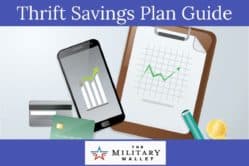Table of Contents
Readers frequently ask how they should handle their cash flow after they reach financial independence. The biggest challenge for military veterans is setting aside enough assets for annual living expenses after separation or retirement.

There’s usually investment income (interest, dividends, capital gains distributions), rental property income, maybe some pension income, and perhaps a little employment income—but these amounts may not cover all of their annual expenses. There’s still a “funding gap” between annual income and expenses, so assets have to be withdrawn from investment accounts. Many military veterans want to withdraw funds from their tax-deferred accounts before they reach age 59½.
I’m going to answer those questions in this 3200-word “pillar post”, which could turn into the Internet’s ultimate guide for Thrift Savings Plan early withdrawals. However, the majority of you will never need to do an early withdrawal from your TSP. I’ll show all of the ways to tap your tax-deferred accounts as early as possible—without penalties—but the best way to handle your financial independence is to design an asset allocation that only needs to tap those accounts after age 59½.
When you minimize your expenses and maximize your savings, then during your military career you’ll pile up your investments in taxable accounts as well as in your TSP and your IRA. When you contribute enough to those taxable accounts then that’s what you’ll spend down after the military, until you can start withdrawals from tax-deferred accounts at age 59½.
I’ll emphasize that point: the easiest answer to handling the funding gap between retiring and age 59½ is to simply set aside enough money in taxable accounts. If you’re planning to leave your tax-deferred accounts alone until age 59½ then you can stop reading right now.
If you’re curious about navigating the tax code, or if you won’t have enough money in taxable accounts, then settle in for a longer read. By the time you’ve absorbed the rest of this post, you may decide that it’s easier to continue minimizing your expenses and saving even more in taxable accounts.
One potential problem with accumulating enough money in taxable accounts is that you need sufficient lead time to execute. This works well if you know that you’re separating after your service obligation, or if you’re planning your retirement well in advance. However, if you make your decision just a year ahead (or if you’re forced out during a drawdown) then you may not have enough time to save up your “funding gap” cash in a taxable account.
Luckily there are several ways to make early withdrawals from tax-deferred accounts. The hard part is avoiding the minefields of taxes & penalties.
Disclaimer: I’m not a financial professional, let alone a CFP or a CPA. I’m just an inquisitive guy who likes to read tax publications and the advice of real financial professionals. I’ll break down these complicated concepts into simple words. If they seem like they’ll work for you, please read the pubs for yourself and then consult your own financial professional.
Another disclaimer: I get this question a lot, so this long post covers the options. The methods described below will work, and they’re perfectly legal. However, they’re complicated and they require considerable advance planning. The “easy answer” is to save up for your funding gap in a taxable account.
Another reason that I’m writing this post is that I finally understand an unusual way to withdraw money from a Roth IRA without paying a penalty: the Roth IRA conversion ladder. It’s one of the most flexible ways to keep compounding your retirement accounts while still using the penalty-free withdrawal option when you need it. However, it takes foresight and planning.
Summary of the Early Withdrawal Options
First, remember that you can withdraw your Roth IRA contributions at any time, even if they’re less than five years old. If you’ve been maximizing Roth IRA contributions since 2000 then this amount is over $80K alone.
Next, let’s review the basic penalty-free early withdrawal options on a Thrift Savings Plan account:
- After you separate from service– when that’s during or after the year you reach age 55.
- A Qualified Reservist Distribution during at least 179 days of active duty.
- Tax-exempt contributions from a combat zone.
- A monthly payment based on your life expectancy.
- A rollover of part or all of your account to an IRA.
Finally, here are the early withdrawal options for a Roth IRA that’s at least five tax years old:
- You can withdraw up to $10K for the purchase of your first home.
- A Qualified Reservist Distribution during at least 179 days of active duty.
- A monthly payment based on your life expectancy.
- The principal of a conversion to a Roth IRA (after five tax years).
- Any of the other unusual situations starting on page 30 of the IRS IRA Pub 590-B.
What works (but not very well)
Note that your TSP early withdrawal option “during or after the year you reach age 55” (instead of age 59½) is only available if you keep working until the year you turn age 55. If you’re retiring before the year in which you turn age 55 then you can’t simply start using this early withdrawal method during the year in which you turn age 55.
If you stop earning your income in your early 50s (or even your 40s) then this early withdrawal option is never available to you. How does the IRS know when you have earned income? By seeing a W-2 or self-employment reporting on your tax returns every year after you leave the military until the year you turn age 55.
TSP contributions from a combat zone are always tax-free when withdrawn, so that may seem like an attractive option. However, the TSP won’t simply cut you a check from the tax-free portion of your account. Instead, the TSP website says that “withdrawals from a uniformed services account will be made pro-rata (i.e., proportionally) from taxable and nontaxable amounts”. An attempt to tap the tax-free portion of the TSP means that you’ll also end up withdrawing some taxable contributions, and there may be additional penalties on those taxable amounts.
Some of you are already thinking “Yeah, but what about the Roth TSP?” Early withdrawals from the TSP are already complicated enough, and Roth TSP accounts make it even more complex. One way to separate your tax-free combat zone contributions from your TSP’s tax-deferred contributions would be to make all combat zone contributions to a Roth TSP account, but that’s currently limited to $23,000/year.
When you’re striving for financial independence you should try to save enough in a combat zone to make the maximum tax-free contributions to your Roth TSP and traditional TSP accounts– up to $69,000 in 2024– even if that someday makes it more difficult to do an early withdrawal. The gains of a maximum TSP contribution will always be more significant (and magnificent!) than the advantages of setting up an early withdrawal.
The early withdrawal option of “monthly payment based on your life expectancy” may also seem like an easy answer, but it’s not. It’s a method of “substantially equal periodic payments” based on section 72(t) of the tax code. It works but it’s complex, inflexible, and administratively painful. It might raise your taxpayer profile for an IRS audit trigger, and if you make an error during the withdrawals then you’ll get a friendly IRS letter inviting you to justify your math. Thousands of taxpayers have successfully executed a 72(t) withdrawal, but I’d use this method only after exhausting all of the other options. I’d also run the plan by a tax professional.
The Roth IRA Conversion Ladder
The key to sustained early withdrawals from your TSP and your Roth IRA in your 40s and 50s is rolling the TSP balance over to a traditional IRA and then converting it to a Roth IRA. The entire balance of the TSP can be rolled over to a traditional IRA at any time, or you can do a partial withdrawal (for a rollover) and convert a portion of your TSP balance to an IRA. The good news is that you can not only roll over your TSP to a traditional IRA, but you can also roll over your Roth TSP to a Roth IRA.
Once a TSP balance has been rolled over to a traditional IRA, the conversion ladder can begin. Each year you’ll convert some of the traditional IRA to a Roth IRA. The amount of each year’s conversion will be your annual “funding gap” before you reach age 59½. CFP Michael Kitces points out that once the converted amount has been in the Roth IRA account for five tax years, it can be withdrawn tax-free.
The amount can be converted any time during a tax year (1 January – 31 December), and the five-year waiting period is considered to start on 1 January. If you do a Roth IRA conversion any time during 2014 then the amount of that conversion can be withdrawn– tax-free and penalty-free– any time after 1 January 2019.
To keep the ladder going, in 2015 you’ll convert more of your traditional IRA to your Roth IRA. You’ll pay the income tax due on that conversion when you file your 2015 tax return, and you can withdraw the amount of that conversion in 2020 (now tax-free and penalty-free).
There’s a wrinkle to each one of these annual conversions: some tax may be due. The amount that’s converted was originally contributed to your TSP, and that amount may include before-tax contributions plus taxable gains. The conversion triggers a tax on those two amounts (but not a penalty) and the tax is due for the tax year in which it’s converted.
The amount subject to tax is calculated by filling out Part III of IRS Form 8606, which (for an IRS form) is surprisingly straightforward. The amount is taxable income, which means that it’s subject to your income tax bracket. If you retire early and have no salary, your income will be in a lower tax bracket than it is during your working years.
The amount of taxable income will be reduced by your deductions, and the amount of the tax might be further reduced by your tax credits. If your expenses and your income are very low then it’s possible that you’d pay no tax at all on the conversion.
You’ll have to pay those taxes shortly after that tax year. The money to pay those taxes should come from other funds– not from the amount that you just converted to the Roth IRA. When you start this Roth IRA conversion ladder, remember to convert a little extra each year to help pay the income taxes that will be due on the later conversions (which you’ll be doing five years from now).
Example of a Roth IRA Conversion Ladder
Complicated, eh? Let me beat two examples into the ground.
In one example, a servicemember might contribute a total of $50K to their traditional TSP during their career through pre-tax payroll deductions. Let’s assume that the TSP account also accumulates unrealized gains of $30K. When the veteran separates, they can roll their traditional TSP over to a traditional IRA. They now have an IRA consisting of $50K of before-tax contributions and $30K of gains.
If they convert that traditional IRA to a Roth IRA in just one transaction, they’ll pay income taxes on the $80K of both contributions & gains. (They pay those taxes from other funds, not from the funds that are converted.) As five more tax years go by, perhaps they contribute another $25K to the Roth IRA while it earns another $35K of gains.
The Roth IRA owner could withdraw that $25K of (additional) contributions at any time. When five tax years have passed after the conversion then the Roth IRA owner can also withdraw the $80K without penalty, and without further taxes. That $80K includes the $50K of original TSP contributions and also the $30K of gains, and they already paid taxes on it five years ago. The only part of the Roth IRA that is still subject to withdrawal restrictions is the $35K of new gains (which have never been taxed and never will be).
Now let’s take a different example with the Roth IRA conversion: instead of doing it all in one tax year, its ladder could be stretched out over many years.
When a 45-year-old veteran separates in 2014, they want to start their conversion ladder right away. Their savings in taxable accounts will last for at least five years, but after that, they’ll need to make early withdrawals to bridge the funding gap.
They estimate that they’ll need $10K in five years and $10K every year after that until turning age 59½. In 2014, they convert $11K of their traditional IRA to a Roth IRA. (They convert the extra $1000 to cover the taxes due on the conversion that they’ll make in 2019.) They fill out Part III of IRS Form 8606 to (magically) determine the taxable income of that conversion, and they report it on their 2014 income tax return. Unfortunately for the first five years of conversions, they’ll have to pay any taxes due on the conversion from the funds in their taxable accounts, not from the converted funds.
They continue converting $11K each year until the traditional IRA balance is now all in the Roth IRA. The original $80K TSP balance has also earned some gains while it was sitting in the traditional IRA, so it will take at least eight years (and probably over 10 years) to convert $11K/year.
On 2 January 2019, it’s been five tax years since the first Roth IRA conversion. The $11K of the 2014 conversion can now be withdrawn with no additional taxes (and no penalties). $10K covers the funding gap that they originally forecast, and the extra $1000 pays the taxes due on the $11K that they’ll convert later in 2019.
Their taxable account lasted for the first five years while they were filling the Roth IRA conversion ladder. If it takes 10 years (minimum) to convert all of the TSP balance (and its additional gains while sitting in the traditional IRA) then they’ll reach age 59½ before they’ve spent all of the IRA conversion funds. They’ll still have a (small) balance in their Roth IRA which they can withdraw whenever they want– now they’re old enough that it’s no longer an early withdrawal.
Early Withdrawal Priority Order
Now that you know your options, you can plan ahead.
While you’re in the military, you’ll attempt to maximize your annual contributions to your Roth TSP and your Roth IRA. You’ll also try to maximize your tax-free contributions from combat zones, first in your Roth TSP and then in your TSP. You’ll try to save even more money in taxable accounts.
As soon as you know the date of your separation/retirement, you’ll forecast your annual income and determine the annual funding gaps between your last military paycheck and age 59½. Part of your plan is a five-year IRA conversion ladder, and the amounts of each year’s Roth IRA conversion should include a little extra to pay taxes on a subsequent conversion. If you’re forecasting early withdrawals over more than five years then you may also want to project a 2-3% annual personal inflation rate to your spending.
After you separate you start spending the money in your taxable accounts. (The easy answer!) You’ll also know how much you’ve contributed to your Roth IRA, so after spending down your taxable accounts you can spend the Roth IRA contributions. You’ll also figure out when you’ll need to tap your TSP account, and you’ll start the TSP rollover/Roth conversion ladder at least five tax years before you need to spend any TSP funds.
By the time you’ve spent your taxable accounts and your Roth IRA contributions, your Roth IRA conversion ladder will have been operating for (at least) five tax years. Now you’ll withdraw the amount that you converted at least five years ago. You’ll also keep the ladder going by converting another year’s funding gap of your traditional IRA to a Roth IRA. You’ll keep that up until all of your traditional IRA has been converted to a Roth IRA.
In an ideal world, when you’re in uniform your expenses would be so low that you’d maximize your TSP & IRA contributions while piling up even more in taxable accounts. In real life, before you separate you might have to cut back on your TSP & IRA contributions to pile up the cash in your taxable account.
Assets that you’ll need to spend during the first five years after active duty should be in a CD ladder. Money that you’ll need during 5-10 years after active duty should be in I bonds or high-quality short-term bond funds. Any funds that you’ll need more than 10 years after hanging up your uniform could stay in your equity asset allocation, but you’ll want to consider moving it to bonds or CDs when you’re inside the 10-year window.
You can be more aggressive if you have a reliable income from a pension, dividends, or rental properties– but any money that you’ll need to spend during the next 2-3 years should not be in equities. If you encounter a bear market during this spending plan then you want to have at least two years of cash in CDs to ride out the recession until the market recovers.
Your Turn to Take Action!
Early withdrawals are complex. The best way to handle your funding gap is to save enough in taxable accounts, and the next-best option is spending your Roth IRA contributions.
While you’re in uniform, minimize your expenses and save as aggressively as you can. Try to maximize your TSP and Roth IRA contributions. When you reach those limits, contribute even more to taxable accounts. When you decide on your transition date then forecast your spending and decide whether you’ll need to shift most of your annual contributions to taxable accounts.
If you’ve used any of these plans for your own transition, then please share your experience! If you’re planning your transition then let us know what other issues you’ve encountered.
Military Guide to Financial Independence
This book provides servicemembers, veterans, and their families with a critical roadmap for becoming financially independent. Topics include:
- Military pension
- TSP
- Tricare Health System
- & More





Comments:
About the comments on this site:
These responses are not provided or commissioned by the bank advertiser. Responses have not been reviewed, approved or otherwise endorsed by the bank advertiser. It is not the bank advertiser’s responsibility to ensure all posts and/or questions are answered.
Spencer says
Does the rule of 55 apply if you are “retired awaiting pay” from the guard?
Bill Lobo says
I am a 75 year old military retiree. We plan on adding an attachment on my son’s home for us to use. Can I get a tax reduction for paying this house attachment if the house is actually owned by our son? We have never owned a house before.
Doug Nordman says
Bill, I’m not a tax expert and this question is outside my circle of competence. My first suggestion is to consult a fee-only advice-only CFP, CPA, or tax expert (Enrolled Agent). I can refer you to vets with those certifications who are also familiar with military benefits.
It’s hypothetically possible to get a tax deduction for medical expenses or to modify a residence for handicapped access. However you’re not the homeowner, and some of those deductions might only apply to a homeowner. You and your son should compare your income-tax brackets and deductions with a tax professional to decide who could take the deduction and how much you’d benefit from it.
A homeowner can use the cost of home improvements to raise the cost basis of the home. This reduces the capital-gains tax on the home when it’s sold, but it’s only available to the homeowner (not a tenant). It wouldn’t directly benefit you, although it might benefit your son if he someday sold the home.
A homeowner can also receive a tax credit for energy-efficiency improvements. Your son could receive tax credits (or deductions) for building the addition with certain types of windows, insulation, water heaters, roofing, wind-resistant designs/materials, or solar panels. This costs more money up front, although some of it is reimbursed by tax credits or deductions. The real benefit is lower utility bills or lower home-insurance premiums.
I’d talk with a VA Veteran Service Officer or a VA lender to see whether you can use your VA disability rating (or your other VA benefits) to qualify for a low-income housing grant or a low-interest loan. You’d be able to stretch out the withdrawals from your TSP or IRA in smaller increments over the years, hopefully in a lower income-tax bracket. However you’d also have to consider the cost of the loan’s interest payments.
The tax code allows anyone to gift anyone else a certain amount of money each year without affecting your threshold for your estate to pay an inheritance tax. (The gift is also tax-free to the recipient. It’s not even reported on an income-tax return.) In 2020 that limit is $15,000/year. You wouldn’t receive a tax credit or a deduction for this, but it’s a simple way to reimburse your son for his home-improvement expenses. Depending on the number of people in your families, this could allow you to transfer large annual sums with no impact on your estate-tax deduction. For example you and your spouse could each gift $15K to your son, and you could each gift $15K to his spouse, and you could each gift $15K to one of your grandchildren. That’s $90K per year.
Once you move into the addition, your son could charge you a market rent. That would enable him (the landlord) to deduct some of his expenses of running a rental property, although he’d also have to pay taxes on the rental income. You’d absolutely want to have a financial professional do the math on this tactic to decide whether it makes more sense to pay rent to your son or to gift him.
Travis says
Doug, I want to make sure I understand this. I am 26, an E6 in the USAF with 14 years until retirement. I want to start planning now. I currently have 10k in my Roth TSP.
If I contribute to my Roth TSP and want to do the conversion ladder… How would I do it? I don’t believe I can transfer the Roth TSP to a traditional IRA to do the conversion to a Roth IRA. Right? So how would the ladder work for me?
I am currently putting about 10% of my income into the Roth TSP. Should I be prioritize putting money into a Roth IRA first? Then TSP?
Thanks for your help/advice!
Doug Nordman says
Thanks for asking the question, Travis, you’re absolutely right to check that you have it covered.
Fortunately a Roth TSP is one of the easiest cases of the early-withdrawal bunch. It’s a category of the Roth 401(k), also known as a “designated Roth account”.
Once you’ve hung up your uniform (separated or retired) then you simply roll your Roth TSP over to a Roth IRA. After five tax years have passed then you can tap the amount of the Roth TSP rollover (but not the new gains in the Roth IRA!) tax-free and penalty-free.
If you want to dig into the tax code with a financial advisor then I’d recommend this outstanding detailed post from CFP Michael Kitces. Read the section titled “5-Year Rule For Designated Roth Accounts Under A 401(k) Or Other Employer Retirement Plan” at:
https://www.kitces.com/blog/understanding-the-two-5-year-rules-for-roth-ira-contributions-and-conversions/
If you’re one of many servicemembers who have combat zone tax-exempt pay in their Roth TSP, then check with your Roth IRA custodian to see how they’ll handle the tax-free portion. Many of them will not track the basis of that portion of the contributions in a Roth IRA, and a few of them won’t even accept tax-free contributions.
Em says
I’m trying to determine if I can withdraw my Roth IRA account? I retired 4 years ago and was rated 100% service connected disability. Will I have to pay the 10% penalty? I can’t seem to get a straight answer. Thanks for any help you can give.
Doug Nordman says
That’s a good question, Em, because you’re considered 100% disabled by the military and the VA.
I think you’re eligible to make a penalty-free distribution, but some conditions apply. The best way to handle this question is to consult a fee-only CPA or tax preparer. If you’re near a military base then you could also consult their VITA office (during tax-prep time), but that only helps for deciding what to do next year.
Let me answer your question for both the Thrift Savings Plan and IRAs.
Here’s the IRS rules for permanent disability:
A person is permanently and totally disabled if both 1 and 2 below apply.
1. He or she can’t engage in any substantial gainful activity because of a physical or mental condition.
2. A qualified physician determines that the condition has lasted or can be expected to last continuously for at least a year or can be expected to result in death.”
https://www.irs.gov/instructions/i1040sr/ar01.html#d0e111
The TSP website says: “Permanent Disability – For the purposes of determining whether Roth earnings are qualified, the TSP cannot certify to the IRS that you meet the IRC’s definition of a disability. You must provide this justification to the IRS when you file your taxes.”
https://www.tsp.gov/sitehelp/content/glossary.html
That’s also in the TSP withdrawal instructions.
https://www.tsp.gov/PDF/formspubs/tsp-77.pdf
You probably meet the conditions for a TSP withdrawal, and the TSP will probably give you the money.
The IRS Pub 590-B handles disability withdrawals:
“Disabled. If you become disabled before you reach age 59 1/2, any distributions from your traditional IRA because ofyour disability are not subject to the 10% additional tax. You are considered disabled if you can furnish proof that you cannot do any substantial gainful activity because of your physical or mental condition. A physician must determine that your condition can be expected to result in death or to be of long, continued, and indefinite duration.”
“A qualified distribution is any payment or distribution from your Roth IRA that meets the following requirements:
1. It is made after the 5-year period beginning with the first taxable year for which a contribution was made to a Roth IRA set up for your benefit, and
2. The payment or distribution is:
a. Made on or after the date you reach age 59 1/2, or
b. Made because you are disabled (defined earlier)…”
You’ll also need the correct distribution code on the 1099-R that your IRA custodian issues for tax returns:
“Number codes. Some of the number codes are explained below. All of the codes are explained in the instructions for recipients on Form 1099-R.
1—Early distribution, no known exception.
2—Early distribution, exception applies.
3—Disability…”
That’s on pages 21, 25, and 30 of this PDF file, and the flowchart on page 32:
https://www.irs.gov/pub/irs-pdf/p590b.pdf
Ben says
If you roll some/all of your Roth TSP to a Roth IRA after separating, how would this conversion amount be treated? Specifically, would it A) all be treated as a contribution to the IRA, B) the 18,000 you contributed to the Roth TSP as a contribution and any growth treated as gains, or C) not treated as a contribution at all? I guess my fundamental question is how much of this rollover amount would be able to be accessed early once in the Roth IRA? From my limited research in to 401k rollovers in general, it appears that the entire rollover amount from a roth 401k is treated as a contribution, and could then be pulled out penalty and tax free. Does anyone have any more information on the rules surrounding the roth TSP specifically, or a publication they can point to?
Doug Nordman says
Excellent question, Ben!
The amount that you sent from the Roth TSP to the Roth IRA is just a rollover. It’s not a contribution to your IRA because it was contributed to your Roth TSP. (You could still contribute $5500 to the Roth IRA for that year.) The amount of the rollover is indeed a combination of the Roth TSP’s contributions and growth, but it’s still counted as a rollover. (There’s no tax due on the gains.) The TSP will send a 1099-R to the IRS (and a copy to you) classifying the move as a rollover, with no penalties or taxes due.
After five tax years you can withdraw the amount that you rolled over into that Roth IRA, and that amount is free of penalties & taxes. You can’t give the same treatment to any gains in the Roth IRA which happened during the five tax years, but the rollover amount is free for you. Click through that link to Michael Kitces’ “Nerds Eye View” site for the details of the tax code which allow this great move.